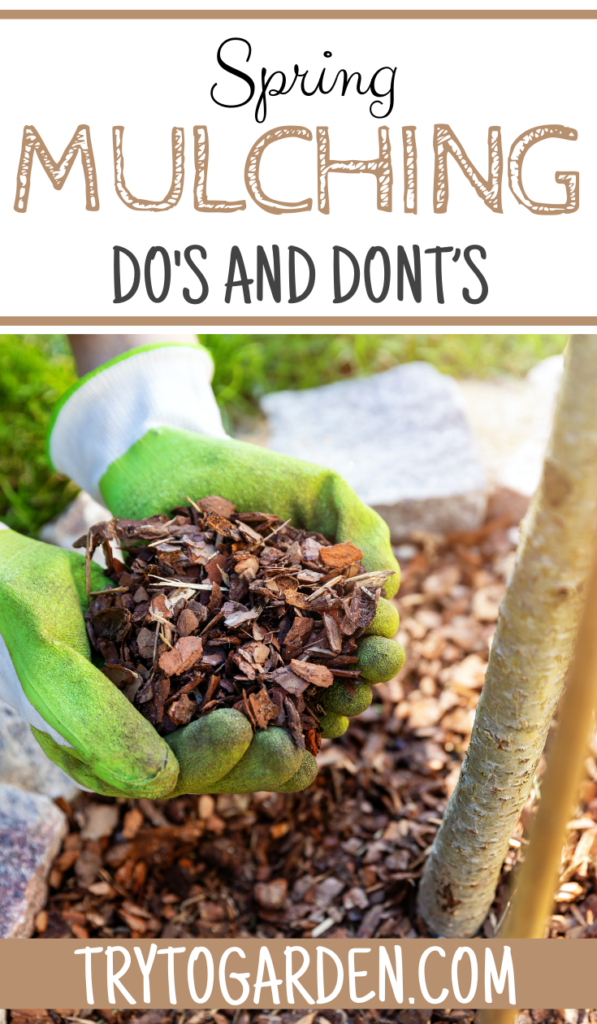This post contains affiliate links, which means I will make a commission at no extra cost to you should you click through and make a purchase. As an Amazon Associate I earn from qualifying purchases.
Spring Mulching Dos and Dont’s? Mulch is a multi-task wonder, and if you've never used it in your garden, you should consider its labor and money-saving benefits.

We have talked about mulch, and compost before - quite a few times, in fact. They are such a great way to build yourself a super-soil for your garden!
Spring Mulching Do's and Dont’s
Many people get a little confused here - they think you should only mulch in the fall.
Is it better to mulch in spring or fall?
Here is the thing: I like spring mulch and a lot of people agree with me. The trick is to not put mulch down too early in the spring.
You need to give the soil a chance to warm up first and if you mulch too early, it will actually slow down the warming process.
Aim for mid to late spring to set your much out - and have no worries about your seedling! They can work their way through a thin layer of mulch - just don't make it too deep a layer.
That being said, many landscaping professionals prefer fall mulching.
Mulch is great to retain soil moisture, suppress weed growth, and protect bare soil from erosion. They feel that by doing in in the fall that it insulates the soil, providing a warmer environment for the soil-food web, including earthworms and microbes. They think it sets up everything perfectly for surviving winter.
Here are some things mulching can do for you and a few spring mulching dos and don'ts you can follow for greater success in your gardening.
What Mulch Can Do For You
Conserve water-improves soil structure-help stop soil compaction-increase aeration and nutrients-suppress grass and weed growth-make your garden and yard more attractive-encourage growth of worms and other beneficial soil organisms
Ten Important Don'ts
1-Don't underestimate the value of a good mulch.
2-Don't remove mulch too early in the spring. Wait until the weather starts to warm up.
3-Don't remove the mulch from the garden when you uncover bulbs. Leave it to surround the bulb bed in case of a late frost, at which time you can use it to cover the bulbs again.
4-Don't mulch too close to your stems and crowns.
5-Don't mulch within six inches of tree trunks.
6-Don't replenish your winter mulch around trees and shrubs until the weather warms up and the soil starts to dry out.
7-Don't mulch heavily where you want a plant to reseed itself. Use only a light mulch such as pine straw that will allow the seed to receive sunlight,
8-Don't assume all mulches are the same in performance. They are not. Where some may conserve water, they may not allow for air movement, and where another may keep the roots cool, it may not allow sufficient water to reach the ground.
9-Don't mulch more than five or six inches around trees and three to five inches around shrubs and plants.
10-Don't forget to add some fresh mulch each year as the old mulch breaks down.
Ten Important Do's
1-Do check out the different mulches and choose the mulch that best blends in with your landscape.
2-Do pull the mulch back from plants after any threat of frost to allow the ground to warm faster.
3-Do pull the mulch back and allow it to surround the bulbs in case of a late freeze, in which case you will want to re-cover the bulbs.
4-Do wait until all danger of frost is past to remove the mulch from the bed. If you plan to mulch that bed, simply rake the mulch you have left surrounding the bed back into place.
5-Do leave a two to three-inch space free of the mulch around each plant to prevent insect damage and rot.
6-Do use a heavy layer of mulch if you live in a dry climate to conserve water and insulate the roots when the ground starts to dry out.
7-Do use heavy mulch wherever you have an erosion problem, such as a bank or high spot in your yard.
8-Do learn about organic mulches and the benefits of using it.
9-Do compare the cost of each type of mulch and how long it lasts before you buy.
10-Do try using black and white newspaper pages under your mulch to save some money and add more nutrients to your soil. According to the USDA, it is safe and effective.
Using mulch properly will lessen your workload in the garden and yard as well as helping your plants, shrubs, and trees. Taking the time to learn spring mulching dos and don'ts will make a big difference in your landscape.
